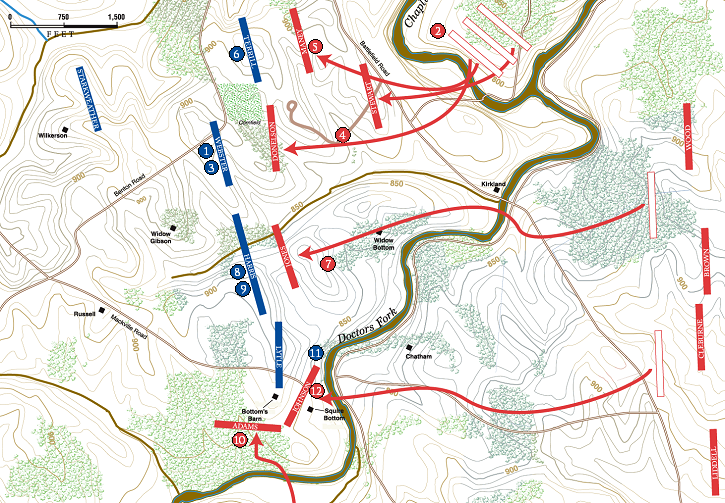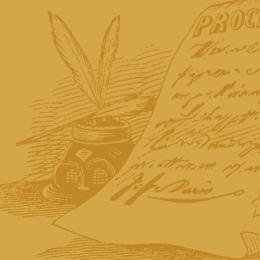Moments in Time: The Battle of Perryville - Part I


Early Afternoon, October 8, 1862
1. “It was really sublime.”—Private Joseph Glezen, 80th Indiana
Private Joseph Glezen of the 80th Indiana Infantry regiment could not contain his emotion as he waited for his first battle to open. From his vantage point on a high hill he watched as the blue and grey battle lines unfolded against each other. Puffs of white smoke rose across the valley, followed seconds later by the deep cracking sound of the shots, as opposing cannons unlimbered and came into action. Milton Spraggins, lying beside him, asked, “Isn’t this terrible?” and received an unexpected response from the forty year-old Glezen. Just then a cannonball struck the ground in front of them, bounced, and sprang through Milton’s skull, killing him instantly. The bloody iron sphere rolled until it rested against the arm of Jesse Spraggins, Milton’s brother.
2. “General, I will obey your orders but if the Sixteenth is to charge that battery you must give the order.”—Colonel John Savage, 16th Tennessee
Colonel John H. Savage led the 16th Tennessee Infantry regiment in General Daniel Donelson’s brigade. Savage was a chronic paranoiac who thought that Donelson, having reached a breaking point after Savage’s frequent insubordination and accusations of drunkenness, was intentionally sending him to his death. Three times Donelson ordered him to attack the Union left, but Savage would not budge. Savage finally responded and, much to Donelson’s surprise, demanded orders. Now very agitated, Donelson shouted “Charge!” in Savage’s face for the fourth time. Now, at around two in the afternoon, the Confederate assault was underway.
3. “We all bounded to our feet like so many parched peas, determined to pour the contents of our muskets into the ranks of our ungodly opposers….our bullets found them in their hiding places and strewd the ground with their mutilated carcasses—the legitimate fruits of their own treason and folly.”—Joseph Glezen, 80th Indiana
Joseph Glezen and his comrades met the Confederates with musketry as they surged towards the Union-held ridge. Bloodied but unbowed, Donelson’s men responded with crashing volleys of their own. In the heat of battle Glezen accidentally loaded his musket twice, causing it to jam. Picking through the weapons of his fallen comrades, it took the Indiana soldier seven tries before he found one that wasn’t jammed in the same way. On the other side, the 16th Tennessee fought from in and around the Widow Gibson’s outbuildings. Colonel Savage ducked behind a cabin corner and kept an eye on the Federal cannons as bullets ripped splinters out of the wooden walls. Whenever he saw a cannoneer load a fresh charge he would shout at his men to take cover in the seconds before the gun fired.
4. “The boys were falling dead and wounded all around me and I thought all would be killed. Some of my school mates and playmates, neighbors and friends lost their lives there….If you wish to know how a soldier feels in such a battle as that, you must ask someone else. I cannot explain, but I had no hope of getting out alive.”—Private Carroll H. Clark, 16th Tennessee
Carroll Henderson Clark was a twenty year-old farmer who had spent the past year and a half as a private in the 16th Tennessee. When his regiment ducked behind a small fold in the ground to reorganize out of sight of Simonson’s guns, another battery took aim at their flank and suddenly the Tennesseans were engulfed in a hellish crossfire. The rest of Donelson’s men raced ahead to relieve the pressure on their comrades as Clark tumbled to the ground, a shell fragment lodged deep in his thigh.
5. “The whole world had been converted into blue coats, whistling balls, bursting shells and brass cannon….The clear voice of brave Frank McWhorter rang out, ‘Die, my comrades, rather than give it up!’”—Unknown, 41st Georgia
With Donelson’s attack swallowed up by smoke and blood the Confederates committed more men against the Union left. George Maney’s brigade was next in line, crossing the dry gully of the Chaplin River and striking William Terrill’s Union brigade on a bald hill known to the locals as Open Knob. Maney’s Georgians and Tennesseans were some of the best shock troops in Bragg’s army, veterans of Shiloh, yet the fury of the northern fire momentarily stopped them in their tracks. The Confederates took cover behind a rail fence and swept the crest of Open Knob with musketry. Reinforcements from both sides rushed to extend the battle line as a grueling firefight roared to life on the extreme Federal flank.
6. “The shells from the enemy’s battery flew over our heads and cut the limbs of the trees by which we stood, sending down a shower of acorns. Bullets pattered about us….Men were coming back from the hell which the crest hid from our view, some wounded, some stragglers.”—1st Lieutenant Albion Tourgee, 105th Ohio
Fighting for breath after sprinting half a mile from reserve to reinforce the defenders of Open Knob, Albion Tourgee met pandemonium on the exposed hilltop. The Confederate volleys were beginning to shake the mostly rookie Union defenders. To make matters worse, General William Terrill, his commanding officer, seemed to have broken under the pressure. Tourgee watched as Terrill ordered the 123rd Illinois regiment to fix bayonets and charge hopelessly at Maney’s strong position along the fence. The Illinoisans came streaming back over the crest mere minutes later, leaving over a hundred men dead and wounded in the grass in front of the unmoved Confederate veterans.
7. “Forward the skirmishers!”—Lieutenant Colonel James Autry, 27th Mississippi
The Confederate line at Perryville moved forward from north to south in what is called an “in echelon” attack, meaning that each unit waits for the one before to make contact with the enemy before beginning its own advance. Ideally, an attack in echelon would compel the defenders to commit men to each successive point of contact until their reserves were depleted, at which point the next attacking unit would break through the line. True to their role, Colonel Thomas Jones’s Mississippi brigade began their march into the Doctor’s Fork valley at around 2:30 in the afternoon. Men from Company K of the 27th Mississippi led the advance in small groups, picking their way through the yellow grass in skirmish formation. Cresting a rise on the other side of the dry gully, the Mississippians could see a formidable line of Union infantry and artillery on the next ridgeline. Hesitating momentarily, they were unceremoniously goaded forward by their commanding officer.
8. “Suddenly there emerged from the wood the head of a column of men…their bayonets glistened in the sun, and then I knew they were coming for us”—1st Lieutenant George Landrum, 2nd Ohio
George Landrum served as a signalman in the 2nd Ohio Infantry regiment. Perryville was his first battle, and as the Confederates advanced he knew he was about to see his first combat, an experience that veterans called “seeing the elephant.” He dashed to a nearby group of cannons under the command of Peter Simonson and pleaded for help. Simonson’s guns quickly opened a terrible fire on the onrushing grey soldiers.
9. “We layed still…and watched our battery throw death into the rebels, we could see awful gaps in their ranks and then they would close up and march over their comrads, never stopping untill they got within 30 rods of us and just as they got on the top of a knowl the colonel called out for us to up and at them and we pored in a deadly fire into them.”—Private Frank Phelps, 10th Wisconsin
Descending into the ravine, Jones’s brigade came within range of the Federals positioned on the high ground. Four separate charges collapsed under the withering firepower. Like walking into tornado winds, they could go no further against such sheets of lead and iron. Pouring volleys down the hillside, Frank Phelps and his blue-clad comrades sent the Confederates scattering back to safety on the other side of the ridge. Over four hundred and fifty Mississippians were killed or wounded in Jones’s botched assault.
10. “Suddenly the brass bands broke loose and filled the woods full of music.”—John W. Headley, Confederate scout
Meanwhile, Brigadier General Daniel Adams led 1,900 Confederates around the southern end of the Union line. Headley and his companions nervously picked their way through dense woods on their way towards the rising sound of gunfire. As they neared the edge of the trees the band struck up a defiant tune, steeling the men for the work ahead.
11. “Oliver Buzingham was killed by my side as we retreated up the hill. He was struck with a ball in the back he fell and ask me for help but there was no place to stop and help wounded men.”—Private William Stuckey, 10th Ohio
As Jones’s attack evaporated to his right, Confederate general Bushrod Johnson led his brigade forward. A small detachment of Union soldiers were searching for drinkable water in Doctor’s Fork when 1,500 Confederates suddenly appeared on the precipice above them. Chaos swept through the gulch as the Federals tried to scramble up the western bank under a murderous fire. Men like William Stuckey were faced with nightmarish choices as they fled back to the Union line.
12. “Myself and three others were trying to shoot through that hole, and we were in each other’s way. So I told them to do the loading and I would do the shooting, and thus we continued until the enemy fled.”—Private W.C. Gipson, 17th Tennessee
W.C. Gipson was part of Bushrod Johnson’s brigade. Pushing terrified Union skirmishers before them, Johnson’s men struck the main body of William Lytle’s brigade near the Squire Bottom farmhouse. Gipson and his comrades had taken cover behind a ramshackle stone fence, muskets flaring on both sides, when a cannonball crashed through the Bottom barn and ignited the dry cotton inside. Massive clouds of choking smoke began to roll through the sector. The heat of the flames increased the pressure on the Federal defenders posted along the nearby fences. Johnson’s veterans sent volley after volley ripping through the blue ranks. At this moment Adams’s brigade appeared on the undefended right flank and opened fire. Taking fearful casualties, Lytle’s inexperienced men fell back towards Russell Hill.
Moments in Time at Perryville: Introduction | Part II | Part III



